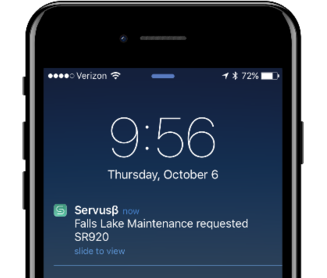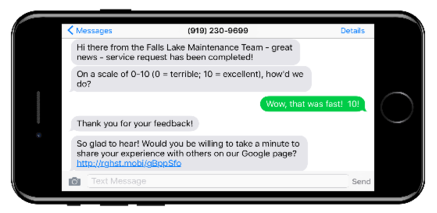Your residents have something to say, but are you giving them a voice?
We all know how important online reviews have become in attracting new residents.
We also know what it's like to be flamed on an apartment online review site by a frustrated resident who claims you "never listened or resolved my issue on multiple attempts".
The reality is that ~20% of the time there is a disconnect between a resident's expectation of what the issue is and what your technicians actually fixed.
Regardless of best intentions, you could still be missing the mark.
Here are three quick guidelines for better identifying and remediating this mis-alignment before it boils-over online:
1. Speed Kills
Get your service notifications and survey out to residents asap, ideally the same day services were rendered.
If there is an issue, its top of mind for the resident and they are much more likely to tell you about it.
Even if your staff got something wrong, your event-driven resident notification was quickly delivered, allowing the resident to alert you before frustration sets in.
2. Medium Matters
Is your followup in a communication channel your resident's prefer?
Ideally, your onsite leasing agents or customer service reps would personally talk to each resident to make sure they are satisfied with their repairs. Unfortunately, this is hard to consistently execute.
SMS (text) messaging is a great alternative and a medium you should consider trying. According to Mobile Market Watch, SMS has a 98% open rate versus 22% for email, which dramatically improves your chances of identifying that 20% mis-alignment in expectations.
3. Promote Praise
70% of resident responses will be positive. Some of these will be downright gold!
You will get several responses a month that would be great to stream on your marketing website as a way of promoting your great customer service as articulated through the voice of your existing residents.
Your maintenance technicians will also appreciate the positive feedback!
"... (name removed) did a fantastic job! Thank you so much for the care taken in leaving my kitchen spotless!"
If your multifamily apartment operation is looking for a better way to "do maintenance" and improve on your resident followup, schedule a demo - we promise you'll be impressed!
Multifamily Budget Season: 4 Ways To Use Maintenance Data for Smarter Decisions
Property management budgeting season is typically not the highlight of multifamily managers' annual calendar. Off-sites, bootcamps, late nights, endless spreadsheets, stacks of reports to filter through...ugh.
A thorough, well-crafted budget often requires us to step outside of our comfort zone and deal with personnel issues and other things that personally impact the people we work with or for.
Then, if that wasn't bad enough, the budget proposal is just the first step. It is most often followed by upper management/C-level/board review and in many cases, the dreaded word: CUTS. In other words, back to the drawing board.
OK, enough of the doom and gloom; how can maintenance data help?
Data collected within your maintenance operations can be a hidden gem when it comes to the overall condition or staffing of your property from a maintenance perspective. Here are four of our favorite areas to dig into.
Maintenance Categories/Tags
Most property management software tools do a very good job of enabling categorization of requests. Analyzing and sorting work orders/service requests by maintenance category (some systems refer to this as "tagging") can provide a treasure trove of information during the budget process.
Based on multifamily industry data, the average 300-unit property generates an average of 150 resident service requests per month. Add another 50 or so on top of that if your sites track make-ready activities or preventative maintenance. Over the course of a year, or even just six months, there is a lot of valuable information when budget season rolls around.
Export them into a spreadsheet pivot table and see what categories of requests you get most often. Then, dig a little deeper. For example, if 30% of your 150 requests are roof leaks, and you are outsourcing those repairs, take a look at what you are spending with that vendor(s). It might be that a capital project for roof replacements is in order.
Geographic Heat Mapping
Otherwise referred to at geo-mapping, this is a very powerful way to understand the frequency of repairs at specific buildings or addresses. Based on the method explained above of using categories to isolate high-volume repairs, you've identified that you are spending a large amount of money repairing roof leaks.
But wait, do they all need to be replaced? A quick glance at a breakdown of roof leaks using geo-mapping may indicate which buildings to focus on. You may also be able to learn some things from patterns that you see, like south facing roofs are worse than the north-facing roofs. This may help you to decide on which materials or even preventative measures that could be taken.
There are some free cloud-based programs that will do this, or maybe your current property management software does it. Either way, visual representations of data are consumed much faster than text, making this a fast and powerful way to filter through the noise and identify problem areas.
Service Cycle Times & Resident Feedback
Budgeting for staffing of your onsite maintenance teams is a pretty easy task, right? Maybe, maybe not. Not every site is the same across portfolios. Older sites require more repairs; higher-end sites may require a higher level of service, etc. Pretty obvious - so how can maintenance data help?
At the end of the day, your residents will tell you how your are doing, which can assist you in determining if your sites are staffed correctly. Be comparing Resident Feedback with your Service Cycle Times, you will be able to identify sites that are underperforming or performing well.
Service Cycle: this is the total elapsed time from when a resident reports a service issue (creation_time) to the time at which is was successfully resolved (completion_time).
These two metrics have a direct inverse relationship - when one goes up, the other goes down and vice-versa. This is something we track obsessively for our clients and one they have come to rely on as the at-a-glance metric for assessing the operational-maintenance health of a every property in a portfolio.
For budgeting purposes, this relationship can help you assess whether you got it right last year, or help with justification for additional resources.
We talk more about key observations between resident feedback and service cycle times here.
Vendor Spend
Keeping track of vendor spend is no trivial task, especially when you depend on vendors for so many aspects of your maintenance operations (resident requests, make-ready, and preventative maintenance). Having some real-time data on how much you are spending on vendor services per unit per month is an essential piece to your overall budget puzzle.
A combination of vendor spend in addition to the categories/types of requests that you typically outsource can help you to determine whether or not that extermination technician needs a place in your budget for next year.
At the end of the day, the empirical data gathered by a simple analysis of these four areas should not only help you lock in on your multifamily maintenance budget, but also prove helpful in justifying the request to your ownership groups. Good luck this budget season! To learn more about how ServusConnect can help you get the data you need to win in property management, schedule a demo.
Think your multifamily maintenance staff can't learn tech? Think again
The thought of giving your multifamily maintenance technicians something new to learn, especially technology, is not a hill many apartment operators want to climb.
Why is this?
Our knee jerk reaction is to think about the tech who still has a flip-phone, or the one who doesn't speak English well, or the conspiracy theorist on your team that thinks you want to track their every move.
It seems there is a general stigma in multifamily that our maintenance team members are not capable of learning or using technology on a daily basis to do their job.
This could not be more wrong. In the 30-49 age group, which the majority-age maintenance technicians fall into, 89% own "smart" devices. The guy with the flip-phone - these are the outliers; the "1-in-20's".
The reality is that your maintenance staff are already using their smart phones and mobile apps to do their jobs.
Over the past several years, our team has trained hundreds of property-level personnel. Here are four ways your multifamily apartment service technicians and vendors are already power-users of mobile technology:
Text Messaging
If there is one app that is universal, it's text messaging. In fact, in three years of working-with, and training maintenance teams and make-ready vendors on technology for multifamily, we've only encountered one technician who had never sent or received a text message. And yes, he had a flip phone!
Texting is the most widely-used and frequently used app on a smartphone, with 97% of Americans using it at least once a day. (Pew Internet)
From texting photos & videos of issues to each other for collaborative troubleshooting, to coordinating make-ready tasks with vendors, text is the absolute killer app that your maintenance team members and vendors are already using. And they are using it to actually be useful!
Photos & Videos
Your technicians have a tough job - they spend more time with your residents on a daily basis than almost anyone else in your company. Sometimes things don't go as planned. Sometimes residents have unrealistic expectations.
In either case, the majority of technicians we've spoken with were already using their personal smart phones to take before-and-after photos or videos as a form of physical documentation to protect themselves and the company. They're also taking photos of other issues that may be of concern to their management and sharing those with the maintenance supervisor or property manager via text.
Dropped-Pins (GPS Mapping)
Using GPS mapping apps like Google Maps for directions or traffic conditions from A-to-B is the obvious use-case and heavily used by tech's and vendors alike. But, in our travels we found that multifamily maintenance technicians were power-users of these mapping apps.
They were doing things like using zoomed-in satellite views of properties and dropped-pin functionality to lock in on things like irrigation or roof leaks and then sharing the maps with vendors via text so they know exactly where to go when they get onsite. No coaching or training - they just figured it out!
Language Translation
Your residents and technicians can come from diverse backgrounds. They may not always speak the same language, or even the same accent or dialect in a common language. When it comes to describing where, what, and why something needs to be repaired in an apartment, translation can be a major issue.
The vast majority of non-English speaking maintenance technicians we encountered were already using a super-easy-to-use language translation app on their personal smartphones called Google Translate.
Google Translate supports over 100 languages at various levels and as of May 2017, serves over 500 million people daily. (Wikipedia)
If you are not already familiar with this nifty app, it allows you to type or even have a conversation between 2 languages. In fact, we now make sure this app is installed on all of the mobile devices we distribute for technicians. If you don’t already have this app on your smartphone, you should download it today!
These are just a few of the ways we have experienced firsthand about how multifamily maintenance teams are already using mobile technologies on the job.
So give your maintenance staff the benefit of the doubt when it comes to technology. Deploying easy-to-use enterprise mobile apps to this user group is not that hard. Beside, there is a reason they are maintenance techs - they have a natural aptitude to figure things out!
In return, get the data you need from operations to make smarter and more informed decisions about your properties. Not only will your staff and residents benefit, but your bottom line will appreciate it too!
*If you are considering deploying a real-time apartment operations apps like ServusConnect for mobile work orders or mobile inspections, schedule a demo.
4 Reasons to Apply Technology to Apartment Maintenance
If you are in the multifamily apartment business, you know this drill:
A resident drops by the office, calls in, or logs into their resident portal to report an issue. When they can get to it, a staff member promptly logs the issue into their property management software, creating a work order for the service team or trusted vendor tasked with performing the repair. The next step?
Print; 2 copies
For the vast majority of owners and operators, technology stops at the printer. The rest of the process is pretty much without it.
And why not? This practice is tried and true, it's been done this way for years and everyone involved understands it. Besides, the industry hasn’t necessarily been on the cutting edge of technology and neither has the vendor community.
Times are Changing
The multifamily industry hand is being forced because resident’s expectations concerning technology is shifting. IT analyst firm Gartner is predicting 25+ billion devices will be connected to the cloud by 2020. For apartment dwellers, think smart speakers, lighting, thermostats, home security devices.
Renters are attracted to this technology for convenience, ease-of-use and immediate access to services. In fact, in a 2017 survey of Apartment Property Managers by Software Advice, respondents indicated that investing in, publicizing and/or incentivizing with smart home features appeals to all types of renters.
This directly translates to apartment services. Residents are expecting even better, more immediate, services from their landlords.
So where does a multifamily operator start?
Applying Technology to Apartment Maintenance
Did you know that the average apartment operator processes 50 resident work orders per month for every 100 managed units? Aside from collecting rent, maintenance is how you interact with your residents the most!
By mobilizing resident repair requests – i.e., digitally routing work orders to a technician or vendor smartphone via an app – apartment operators can benefit in a number of ways. Here are 4 of those ways:
1. Efficiency: The first reason to go mobile is that it provides greater efficiency by eliminating wasted time getting the work order to the right person in order to perform the service. Real time push notifications alert maintenance techs and vendors, allowing them to begin mentally preparing for the work before they head back to the maintenance office.
Users of these systems generally experience a 20% improvement in service cycles (the elapsed time from when a resident calls-in, to when their service is completed). In today’s on-demand society, getting work done faster significantly increases the chance of customer satisfaction.
2. Positively Communicate & Engage with Residents: Most apartment operators strive to, but fall short of, following-up with every resident upon completion of service. What if this follow-up happened automatically? A well-rounded mobile maintenance system can take care of this for you.
Mobile maintenance systems can send automated text messages to residents when their service request has been marked “complete” by the technician or vendor. And text messaging is the perfect technology to reach residents because they are almost always read.
"80% of Americans text regularly and 90% of text messages are read within the first three minutes" - Nexmo
3. Online Reputation Management: By implementing a mobile maintenance system, apartment operators can actually generate organic positive reviews. These systems can instantly survey the resident via text to see how they feel about the service provided. Residents who have good experiences are asked to share them at ApartmentRatings.com, Google, Facebook or elsewhere.
Response rates can also be boosted through incentives like gift cards or drawings. Negative experiences are kept in the private confines of the text message so issues can be addressed prior to leaking out in an online review. The best part? This process is completely hands-off for the apartment management staff so they can focus on leasing and other resident service efforts.
4. Visibility & Reporting: The last reason to implement a mobile maintenance solution is the visibility and reporting these systems can provide. Maintenance operations is an area of significant operational and capital spend for apartment operators.
But outside of insights gained via the balance sheet, very little real or near-
time data has traditionally been available to help apartment operators evaluate how their maintenance teams are performing, how efficient their vendors are, and maybe most importantly, how residents feel about where they live.
By digitizing work orders, transaction data is captured: time stamps, photos, comments, resident responses, etc. This data is extremely valuable in helping multifamily operators keep their maintenance departments operating efficiently and effectively.
At ServusConnect, we are committed to helping multifamily operators experience these benefits through our maintenance automation platform. The ServusConnect platform can plug into any manual operation and work in conjunction with existing work order systems to instantly mobilize operations. Schedule a demo today.









